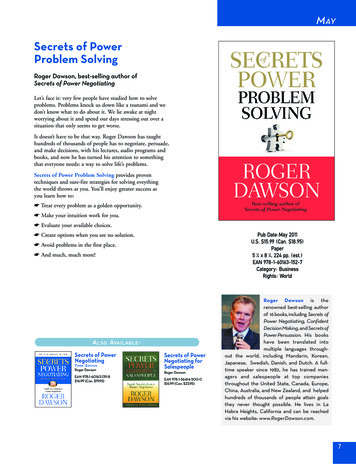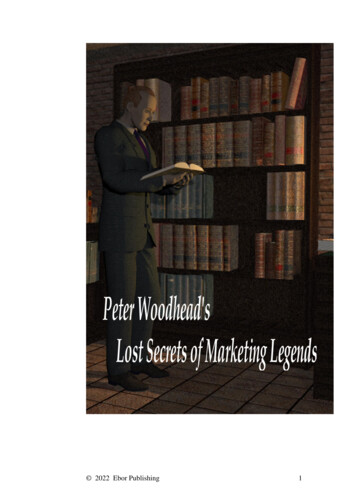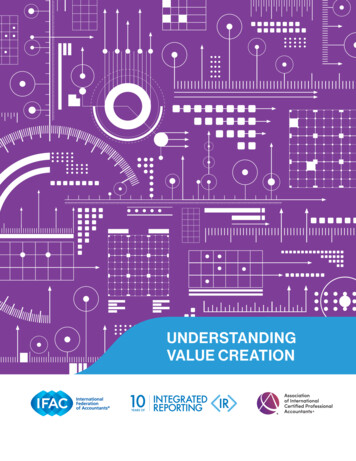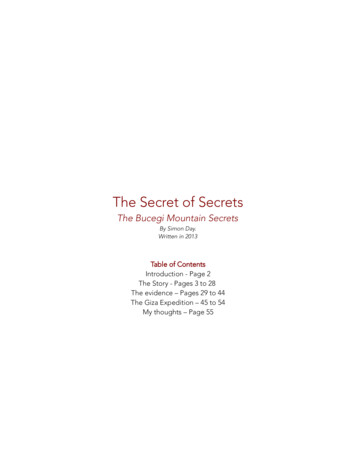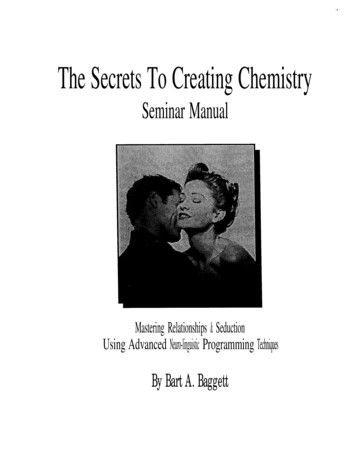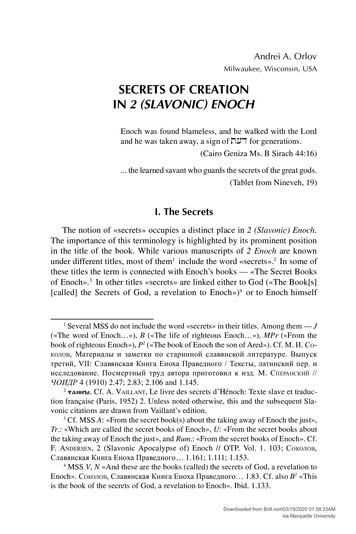
Transcription
Andrei A. OrlovMilwaukee, Wisconsin, USASECRETS OF CREATIONIN 2 (SLAVONIC) ENOCHEnoch was found blameless, and he walked with the Lordand he was taken away, a sign of t(d for generations.(Cairo Geniza Ms. B Sirach 44:16). the learned savant who guards the secrets of the great gods.(Tablet from Nineveh, 19)I. The SecretsThe notion of «secrets» occupies a distinct place in 2 (Slavonic) Enoch.The importance of this terminology is highlighted by its prominent positionin the title of the book. While various manuscripts of 2 Enoch are knownunder different titles, most of them1 include the word «secrets».2 In some ofthese titles the term is connected with Enoch’s books — «The Secret Booksof Enoch».3 In other titles «secrets» are linked either to God («The Book[s][called] the Secrets of God, a revelation to Enoch»)4 or to Enoch himselfSeveral MSS do not include the word «secrets» in their titles. Among them — J(«The word of Enoch »), B («The life of righteous Enoch »), MPr («From thebook of righteous Enoch»), P2 («The book of Enoch the son of Ared»). Cf. Ì. È. ÑÎÊÎËÎÂ, Ìàòåðèàëû è çàìåòêè ïî ñòàðèííîé ñëàâÿíñêîé ëèòåðàòóðå. Âûïóñêòðåòèé, VII: Ñëàâÿíñêàÿ Êíèãà Åíîõà Ïðàâåäíîãî / Òåêñòû, ëàòèíñêèé ïåð. èèññëåäîâàíèå. Ïîñìåðòíûé òðóä àâòîðà ïðèãîòîâèë ê èçä. Ì. ÑÏÅÐÀÍÑÊÈÉ // ÎÈÄÐ 4 (1910) 2.47; 2.83; 2.106 and 1.145.2tainy. Cf. A. VAILLANT, Le livre des secrets d’Hénoch: Texte slave et traduction française (Paris, 1952) 2. Unless noted otherwise, this and the subsequent Slavonic citations are drawn from Vaillant’s edition.3Cf. MSS A: «From the secret book(s) about the taking away of Enoch the just»,Tr.: «Which are called the secret books of Enoch», U: «From the secret books aboutthe taking away of Enoch the just», and Rum.: «From the secret books of Enoch». Cf.F. ANDERSEN, 2 (Slavonic Apocalypse of) Enoch // OTP. Vol. 1. 103; Ñ ÎÊÎËÎÂ,Ñëàâÿíñêàÿ Êíèãà Åíîõà Ïðàâåäíîãî 1.161; 1.111; 1.153.4MSS V, N «And these are the books (called) the secrets of God, a revelation toEnoch». ÑÎÊÎËÎÂ, Ñëàâÿíñêàÿ Êíèãà Åíîõà Ïðàâåäíîãî 1.83. Cf. also B2 «Thisis the book of the secrets of God, a revelation to Enoch». Ibid. 1.133.1Downloaded from Brill.com03/15/2020 01:58:33AMvia Marquette University
Andrei A. Orlov433(«The Book of the Secrets of Enoch»).5 This consistency in the use of theterm «secrets», in spite of its varied attribution to different subjects, mayindicate that the authors and/or the transmitters of the text viewed the motifof «secrets» as a central theme of the apocalypse. The purpose of this chapteris to call attention to some details of this theme in 2 Enoch.The StoryDespite the prominent role the word «secrets» seems to play in the titlesof the book, it occurs, quite unexpectedly, only three times in the main bodyof 2 Enoch, twice in chapter 24 and once in chapter 36. It is not, however,coincidental that the term is found in this section of the book. Chapters 24–36 of 2 Enoch can be viewed as the climax of angelic and divine revelationsto Enoch during his celestial tour. From these chapters we learn that Enoch,previously described to have been «placed» into the clothes of glory and instructed by the archangel Vereveil, was called by the Lord. The book tellsthat the Lord decided to reveal to Enoch the secrets of his creation, which henever explained even to his angels. Further the term «secrets» is applied onlyto this account of God’s creation, conveyed to Enoch by the Lord himself,«face to face».6 The content of these revelations includes the following details:1. Prior to the creation the Lord decided to establish the foundation of allcreated things;2. He commanded one of the invisible «things» to come out of the verylowest darkness and become visible;3. By Lord’s command a primordial «great aeon», bearing the name Adoil,descended and, disintegrating himself, revealed all creation which the Lord«had thought up to create»;74. The Lord created a throne for himself. He then ordered the light tobecome the foundation for the highest things;5. The Lord called out the second aeon, bearing the name Arukhas, whobecame the foundation of the lowest things;6. From the waters the Lord «hardened big stones», establishing the solidstructure above the waters;7. The Lord fashioned the heavens and the sun;8. From fire the Lord created the armies of «the bodiless ones»;9. The Lord created vegetation, fish, reptiles, birds, and animals;10. The Lord created man.Cf. P «The book about the secrets of Enoch, the son of Ared», and R «Thebooks of the holy secrets of Enoch » Cf. VAILLANT, Le livre des secrets d’Hénoch 2; ÑÎÊÎËÎÂ, Ñëàâÿíñêàÿ Êíèãà Åíîõà Ïðàâåäíîãî 1.1.6ANDERSEN, 2 Enoch 140.7Ibid. 144.5Downloaded from Brill.com03/15/2020 01:58:33AMvia Marquette University
434Scrinium III (2007). The Theophaneia SchoolWhile the general structure of the account of creation appears to be similar in the shorter and the longer recension, the latter offers a lengthy accountdedicated to Adam’s creation and his transgression.Let it be also noted that the notion of «secrets» sets symbolic boundariesfor the story of creation; it begins and closes the account of creation. In chapter 24 the Lord tells Enoch that he wants to instruct him in His secrets. Insome manuscripts of the longer recension, chapter 24 even has a specificheading, «About the great secrets of God, which God revealed and related toEnoch; and he spoke with him face to face».8 In chapter 36, which serves asa conclusion of the Lord’s instruction, the Lord promises Enoch the role ofthe expert in His secrets — «Because a place has been prepared for you, andyou will be in front of my face from now and forever. And you will be seeingmy secrets (tainy moÿ).».9Expert in SecretsThe tradition about Enoch as an expert in God’s secrets does not begin in2 Enoch. Already in the earliest Enochic books of 1 (Ethiopic) Enoch, theknowledge and the revelation of secrets become major functions of the elevated Enoch.10 Later Enochic traditions also emphasize the role of Enoch asthe «Knower of Secrets» (Myzr (dwy). According to 3 Enoch, Enoch-Metatron is able to behold «deep secrets and wonderful mysteries».11 In thisMerkabah text Metatron is also responsible for transmitting the highest secrets to the Princes under him, as well as to humankind. H. Kvanvig observesthat «in Jewish tradition Enoch is primarily portrayed as a primeval sage, theultimate revealer of divine secrets».12Two recent important studies13 in Enochic traditions trace the origin ofthe image of Enoch as a primeval sage preoccupied with divine secrets toANDERSEN, 2 Enoch 140.Ibid. 161.10The origin of the role in Enochic traditions can be traced to 1 Enoch 72:1, 74:2,and 80:1. In 1 Enoch 41:1 Enoch is attested as the one who «saw all secrets of heaven ». M. KNIBB, The Ethiopic Book of Enoch. 2 vols (Oxford, 1978) Vol. 2. 128.113 Enoch 11:2. Here and later I have used Philip Alexander’s English translationof 3 Enoch, and follow his division in chapters. Cf. P. ALEXANDER, 3 (Hebrew Apocalypse of) Enoch // OTP. Vol. 1. 264.12H. S. KVANVIG, Roots of Apocalyptic: the Mesopotamian Background of theEnoch Figure and of the Son of Man (Neukirchen-Vluyn, 1988) (WMANT, 61) 27.13J. VANDERKAM, Enoch and the Growth of an Apocalyptic Tradition (Washington, 1984) (CBQMS, 16); KVANVIG, Roots of Apocalyptic On Mesopotamian originsof Enoch’s figure, see also: H. ZIMMERN, Urkönige und Uroffenbarung // E. SCHRADER, Die Keilinschriften und das Alte Testament. 2 vols (Berlin, 1902–1903) Vol. 2.530–543; H. L. JANSEN, Die Henochgestalt: Eine vergleichende religionsgeschichtliche Untersuchung (Oslo, 1939) (Norske Videnskaps-Akademi i Oslo II. Hist.-Filos.89Downloaded from Brill.com03/15/2020 01:58:33AMvia Marquette University
Andrei A. Orlov435some heroes of the Mesopotamian lore. According to these studies, one ofthese possible prototypes can be an intriguing character of the «Sumerian»Kings list — Enmeduranki, king of Sippar. In three copies of the List heoccupies the seventh place, which in Genesis’ genealogy belongs to Enoch.In other Mesopotamian sources Enmeduranki appears in many roles and situations remarkably similar to Enoch’s story. Among these roles are that of theknower and the guardian of the secrets of gods.14The tablet from Nineveh, possibly dated before 1100 B.C.E., is a primarywitness to the parallels between the stories of Enoch and Enmeduranki.15The text, reconstructed by W. G. Lambert,16 describes Enmeduranki’s initiation into the divine secrets and attests him as «the learned savant, who guardsthe secrets of the great gods». In this text17 Enmeduranki also functions as aKlasse, 1); P. GRELOT, La légende d’Hénoch dans les apocryphes et dans la Bible:origine et signification // RSR 46 (1958) 5–26, 181–210.14GRELOT, La légende d’Hénoch dans les apocryphes et dans la Bible 182, 186.Enmeduranki was also regarded as the founder of the bârû guild, the elite group ofdiviners, the experts in omens. Cf. VANDERKAM, Enoch and the Growth of an Apocalyptic Tradition 42.15KVANVIG, Roots of Apocalyptic 190.16W. G. LAMBERT, Enmeduranki and Related Matters // JCS 21 (1967) 126–138.17The text reads as follows:3. «Šamaš in Ebabbara [appointed]1. Enmeduranki [king of Sippar],2. the beloved of Anu, Enlil [and Ea].4. Šamaš and Adad [brought him in] to their assembly,5. Šamaš and Adad [honored him],6. Šamaš and Adad [set him] on a large throne of gold,7. They showed him how to observe oil on water, a mystery of Anu, [Enliland Ea],8. They gave him the tablet of the gods, the liver, a secret of heaven and[underworld],9. They put in his hand the cedar[-rod], beloved of the great gods.10. Then he, in accordance with their [word(?)] brought11. the men of Nippur, Sippar and Babylon into his presence,12. and he honoured them. He set them on thrones before [him],13. he showed them how to observe oil on water, a mystery of Anu, Enlil andEa,14. He gave them the tablet of the gods, the liver, a secret of heaven and underworld,15. He put in their hand the cedar[-rod], beloved of the great gods.16. {The tablet of the gods, the liver, a mystery of heaven and underworld;17. how to observe oil on water, a secret of Anu, Enlil and Ea;18. ‘that with commentary’, When Anu, Enlil; and how to make mathematical calculations.}19. The learned savant, who guards the secrets of the great gods,Downloaded from Brill.com03/15/2020 01:58:33AMvia Marquette University
436Scrinium III (2007). The Theophaneia Schoolmediator between the deities and the people of Nippur, Sippar and Babylon.He instructs them in the secrets, which he received from the deities.Kvanvig observes that the tablet emphasizes the esoteric character of thedivine wisdom revealed to Enmeduranki, reinforced by such terms as nis³irtu(mystery) and pirištu (secret).18Another important detail in the passage is the juxtaposition of the terms«secrets» and «mysteries» with the phrases «heaven and underworld» and«heaven and earth». Kvanvig points out that both phrases have a «cosmological» meaning.19 Intended to describe the totality of creation — «the wholeworld», this terminology can also be related to cosmogonic and creationalconcepts.Secrets in Enochic traditionsJust as the role of Enoch as the Knower of secrets does not begin in2 Enoch, so also the information about the heavenly secrets is not peculiaronly to this apocalypse. We encounter this theme in other biblical and thepseudepigraphical texts,20 including the early Enochic booklets of 1 EthiopicEnoch.20. will bind his son whom he loves with an oath21. before Šamaš and Adad by tablet and stylus and22. will instruct him. When a diviner,23. an expert in oil, of abiding descent, offspring of Enmeduranki, king ofSippar,24. who set up the pure bowl and held the cedar[-rod],25. a benediction priest of the king, a long-haired priest of Šamaš26. as fashioned by Ninhursagga,27. begotten by a nišakku-priest of pure descent:28. if he is without blemish in body and limbs29. he may approach the presence of Šamaš and Adad where liver inspection and oracle (take place)».LAMBERT, Enmeduranki and Related Matters. 132.18KVANVIG, Roots of Apocalyptic 188.19Ibid. 188.20On the notion of «secrets» in the Old Testament and the Pseudepigrapha seeM. N. A. BOCKMUEHL, Revelation and Mystery in Ancient Judaism and Pauline Christianity (Tübingen, 1990) (WUNT, 2/136). Qumran texts also use extensively the notions of «secret» (zr) and «special knowledge» (t(d) and apply them to varied things,including the Torah and the halachic preceipts. Cf. BOCKMUEHL, Revelation and Mystery 53–56; W. D. DAVIES, «Knowledge» in the Dead Sea Scrolls and Matthew1.1:25–30 // W. D. DAVIES, Christian Origins and Judaism (Philadelphia, 1962) 119–144; B. REICKE, Dacat and Gnosis in Intertestamental Literature // Neotestamentica etSemitica. Studies in Honor of Matthew Black / Eds. E. EARLE ELLIS, M. WILCOX (Edinburg, 1969) 245–255; H. RINGGREN, Qumran and Gnosticism // Le Origini dello Gnosticismo / Ed. U. BIANCHI (Leiden, 1967) (SHR, 12) 379–388.Downloaded from Brill.com03/15/2020 01:58:33AMvia Marquette University
Andrei A. Orlov4371 Enoch applies the term «secrets» to various things Enoch acquires during his celestial tour. In 41:1–3 Enoch tells about his experience:. I saw all the secrets of heaven, and how the kingdom is divided, and howthe deeds of men are weighed in the balance. There I saw the dwelling ofthe chosen and the resting-places of the holy; and my eyes saw there all thesinners who deny the name of the Lord of Spirits being driven from there,and they dragged them off, and they were not able to remain because of thepunishment which went out from the Lord of Spirits. And there my eyessaw the secrets of the flashes of lightning and the thunder, and the secretsof the winds, how they are distributed in order to blow over the earth, andthe secrets of the clouds and of the dew.21The passage shows that in 1 Enoch the secrets include not only astronomical, cosmological, and calendarical information, but also eschatological details which Enoch acquired either himself or through angelic mediators.22 Theunity between the cosmological and the eschatological, between the secrets of«heaven» and the secrets of «earth», is prominent in 1 Enoch 52:2, whereEnoch attests that he «saw the secrets of heaven, everything that will occur onearth: a mountain of iron, and a mountain of copper, and a mountain of silver,and a mountain of gold, and a mountain of soft metal, and a mountain of lead.all these things which serve the authority of the Messiah».23 Markus Bockmuehl notes that cosmological and eschatological secrets occur repeatedly intandem and show the intimate link between the cosmological mysteries ofheaven and the eschatological questions pursued by the visionaries.24The tendency to include the knowledge about future eschatological eventsin the notion of «secrets» can be found both in the Pseudepigrapha and in theBible. Bockmuehl observes that the term zr in Daniel always relates in someway to a disclosure of the future.25 The labeling of disclosures of the futureas «secrets» becomes a prominent motif in the later «Enochic» text, SeferHekhalot. In 3 Enoch 11:2–3 Enoch-Metatron tells R. Ishmael that from thetime of his elevation he has acquired an ability to see deep secrets and wonderful mysteries.26 According to the text, before a man thinks in secret, Metatron is able see his thought; before a man acts, he can see his act. MetatronKNIBB, The Ethiopic Book of Enoch Vol. 2. 128–129.For a complete discussion about «revealed things» in apocalyptic literature seeM. Stone’s pioneering research in M. STONE, Lists of Revealed Things in the Apocalyptic Literature // Magnalia Dei: The Mighty Acts of God / Eds. F. M. CROSS, W. E. LEMKE,P. D. MILLER, Jr. (New York, 1967) 414–452.23KNIBB, The Ethiopic Book of Enoch Vol. 2. 136.24BOCKMUEHL, Revelation and Mystery 35.25Ibid. 36.26h)lpwm dwsbw hqwm( yzrb lktshl. P. SCHÄFER with M. SCHLÜTER andH. G. VON MUTIUS, Synopse zur Hekhalot-Literatur (Tübingen, 1981) (TSAJ, 2) 9.2122Downloaded from Brill.com03/15/2020 01:58:33AMvia Marquette University
438Scrinium III (2007). The Theophaneia Schoolconcludes that «there is nothing in heaven above or deep within the earthconcealed from me».27 It is clear that the passage understands «secrets» to beforesights of human deeds and thoughts.3 Enoch also demonstrates some other affinities with 1 Enoch in its usageof the notion «secrets». First, it applies the word «secrets» to various revealed«things» — «all mysteries of wisdom, all the depths of the perfect Torah, andthe thoughts of human hearts».28 Second, in similarity with 1 Enoch, it includes eschatological and historical details under the category of the «secrets». Third, the angels in 3 Enoch are aware of God’s secrets: «YHWH theGod of Israel is my witness that when I revealed this secret to Moses, all thearmies of the height, in every heaven, were angry with me.».29 Fourth, Gruenwald’s research emphasizes the close proximity between apocalyptic andMerkabah mysticism in the concept of «secret oath/name» which plays a significant role in the cosmology of 1 Enoch and 3 Enoch.30In contrast to these apocalyptic and Merkabah Enochic texts, 2 Enochoffers a different understanding of «secrets». At least four points of difference need to be noted. First, 2 Enoch does not apply the notion of «secrets» tomany types of revelation. This term occurs very rarely in the book and isreserved only for the particular cosmogonic31 revelation of the Lord. Second,the term is never applied to an earthly affair, not even in reference to historical and eschatological information. Third, the «secret name» does not playany significant role in 2 Enoch’s cosmogony. Fourth, the angels in 2 Enochdo not know about God’s cosmogonic «secrets».Moreover, it seems that in 2 Enoch the realm of the secrets, even «topologically», transcends the angelic world. The shorter recension tells us thatbefore the cosmogonic revelation took place, the Lord had «placed» Enochto the left of Himself, closer than Gabriel.32 Further, the Lord confirms thetranscendence of the knowledge about creation over the angelic world whenHe informs Enoch that even to his angels He has explained neither his secretsnor his «endless and inconceivable creation which He conceived».33ALEXANDER, 3 Enoch 264.3 Enoch 11:1. Cf. ALEXANDER, 3 Enoch 264.29Ibid. 315.30I. GRUENWALD, Apocalyptic and Merkavah Mysticism (Leiden, 1980) (AGJU,14) 10–11.31On cosmogony in 2 Enoch, see S. PINES, Eschatology and the Concept of Timein the Slavonic Book of Enoch // Types of Redemption / Ed. R. J. ZWI WERBLOWSKY,J. JOUCO BLEEKER (Leiden, 1970) (SHR, 18) 72–87; M. PHILONENKO, La cosmogoniedu «Livre des secrets d’Hénoch» // Religions en Égypte: Hellénistique et romaine(Paris, 1969) 109–116; G. SCHOLEM, On the Mystical Shape of the Godhead (NewYork, 1991) 98–101; IDEM, Origins of the Kabbalah (Princeton, 1987).32ANDERSEN, 2 Enoch 143.33Ibid. 143.2728Downloaded from Brill.com03/15/2020 01:58:33AMvia Marquette University
Andrei A. Orlov439The «secrecy» of the Lord’s revelation is underscored further by severaladditional factors.First, immediately following the cosmogonic instructions, the Lord informed Enoch that he appointed an intercessor, the archangel Michael, andguardian angels, Arioch and Marioch,34 for Enoch’s writings which shouldnot perish in the impending flood:For I will give you an intercessor, Enoch, my archistratig, Michael, onaccount of your handwritings and the handwritings of your fathers — Adamand Seth. They will not be destroyed until the final age. For I have commanded my angels Arioch and Marioch, whom I have appointed on theearth to guard them and to command the things of time to preserve thehandwritings of your fathers so that they might not perish in the impendingflood which I will create in your generation (33:10–12).35The motif of the guardian angels of the books is peculiar to the esoterictradition conveyed to Enoch. It might indicate that we are dealing here withthe famous «secret» books by which antediluvian wisdom reached postdeluvian generations. This motif of antediluvian «secret» writings has a numberof parallels in Mesopotamian lore.36Second, the esoteric details of the Lord’s cosmogonic revelations do notappear in chapters 39–66, dedicated to Enoch’s instructions to his children.In these chapters Enoch shares the information about his heavenly tour andhis extraordinary experiences near the Throne of Glory. He conveys to hischildren an esoteric knowledge which includes meteorological, cosmological, and eschatological information. In this section of the book Enoch evenoffers a lengthy description of the Lord’s limbs «without measure and analogy»37 which, some scholars believe, belongs to another highly esoteric trendof Jewish mysticism.38 The full account of God’s cosmogonic revelations,however, does not appear in these instructions of Enoch. Even though thetext makes several allusions to the creation story, telling us that «the Lordwas the one who laid the foundations upon the unknown things and . spreadout the heavens above the visible and the invisible things»,39 Enoch neverdiscloses to his children the full story about Adoil and Arukhas.34On the origin of the names Arioch and Marioch see J. FOSSUM, The Name of Godand the Angel of the Lord (Tübingen, 1985) (WUNT, 36) 321–328; L. GRY, Quelquesnoms d’anges ou d’êtres mystérieux en II Hénoch // RB 49 (1940) 199–200.35ANDERSEN, 2 Enoch 157.36Cf. GRELOT, La légende d’Hénoch dans les apocryphes et dans la Bible 9–13.37ANDERSEN, 2 Enoch 163.38G. Scholem argues that the terminology of this section in 2 Enoch shows apparent similarities to the hmwq rw(y# tradition. Cf. SCHOLEM, On the Mystical Shapeof the Godhead 29.39ANDERSEN, 2 Enoch 174.Downloaded from Brill.com03/15/2020 01:58:33AMvia Marquette University
440Scrinium III (2007). The Theophaneia SchoolII. Secrets of Creation in the Merkabah TraditionDespite the differences in the treatment of «secrets» in 2 Enoch and3 Enoch that have been mentioned earlier, the approach to the mysteries ofcreation found in 3 Enoch demonstrates close affinities with that in the Slavonic Enoch.The theme of the secrets of creation plays an important role in 3 Enoch; itis surrounded by several details found in 2 Enoch. The similarities includethe following points:1. One of these parallels is Enoch’s initiation into the secrets of Creation.The important detail in both texts is that some preparatory instructions beforethe account of creation were given through angels. In the case of 3 Enoch, theinstructions were given through the angels known as the «Prince of Wisdom»(hmkxh r#) and the «Prince of Understanding» (hnybh r#); in the case of2 Enoch they came through the angel Vereveil (Vereveil). In both booksthese angelic mediators do not reveal «secrets» but offer instead somepreparatory knowledge. In 2 Enoch Vereveil instructs Enoch in different«things» — «all things of heaven and earth and sea and all the elements andthe movements and their courses . and the Hebrew language, every kind oflanguage of the new song of the armed troops and everything that it is appropriate to learn» (23:1–2).40 In 3 Enoch the Prince of Wisdom and the Princeof Understanding teach Enoch-Metatron «wisdom» — «the wisdom of thoseabove and those below, the wisdom of this world and the world to come».412. Both texts also mention that immediately after these preparatory angelic instructions, the Lord (the Holy One) reveals «the secrets of creation» toEnoch (Metatron). From 3 Enoch 11:2 we learn that all the secrets of creation(ty#)rb yrts)42 now stand revealed before Enoch-Metatron as they standrevealed before the Creator. In 2 Enoch 24:2–4 the Lord instructs Enoch inthe secrets of his «endless and inconceivable creation», the mysteries whichhe never explained even to his angels:Whatever you see, Enoch, things standing still and moving about and whichwere brought to perfection by me, I myself will explain it to you. And noteven to my angels have I explained my secrets, nor related to them theircomposition, nor my endless and inconceivable creation which I conceived,as I am making them known to you today.433. As was mentioned earlier, the notion of «secrets» in 3 Enoch includesvarious types of revelations. Even though the book applies the term «secrets»ANDERSEN, 2 Enoch 140.ALEXANDER, 3 Enoch 264.42MS M40. Cf. SCHÄFER, Synopse 8. MS V228 instead of «the secrets of creation» uses — «the orders of creation» (ty#)rb yrds). Cf. SCHÄFER, Synopse 9.43ANDERSEN, 2 Enoch 143.4041Downloaded from Brill.com03/15/2020 01:58:33AMvia Marquette University
441Andrei A. Orlovto several things, including the Torah, it also seems to use the notion of «thespecial secret» in reference to certain details of the Account of Creation.According to the book, this special secret plays an important role in «God’screation of everything». We learn about the secret from 3 Enoch 48D, whereMetatron tells R. Ishmael that he was the person who revealed the specialsecret Moses, in spite of the protests of the heavenly hosts:YHWH the God of Israel is my witness that when I revealed this secret toMoses, all the armies of the height, in every heaven, were angry with me.They said to me, «Why are you revealing this secret to humankind, born ofwoman, blemished, unclean, defiled by blood and impure flux, men whoexcrete putrid drops — that secret by which heaven and earth were created, the sea and the dry land, mountains and hills, rivers and springs, Gehinnom, fire and hail, the garden of Eden and the tree of life? By it Adam wasformed, the cattle and the beasts of the field, the birds of heaven and thefish of the sea, Behemoth and Leviathan, the unclean creatures and reptiles, the creeping things of the sea and the reptiles of the deserts, Torah,wisdom, knowledge, thought, the understanding of things above, and thefear of heaven. Why are you revealing it to flesh and blood?»44P. Alexander observes that in this passage «the secret» could be either(1) the Torah, or (2) the secret names of God. He further suggests that «theidentification of the secret with the Torah appears to be excluded by the factthat Torah is one of the things created by the secret».45 This situation in whichthe notion of «secret» transcends the realm of the Torah and refers instead toGod’s creation appears to have close affinities to the position of 2 Enoch,where the Torah is not listed among God’s mysteries.III. Secrets of Creation in the Zoharic TraditionThe cosmogonic account in 2 Enoch demonstrates close similarities notonly with that in the Merkabah tradition46 but also with much later developments of Jewish mysticism. The following analysis is an attempt to tracesome affinities between the account of creation in 2 Enoch and that in somemedieval texts of Jewish mysticism.StonesIn one of his books47 G. Scholem points to an interesting detail in thecreation narrative in 2 Enoch. The story involves the enigmatic stones theALEXANDER, 3 Enoch 315.Ibid. 315.46On the Merkabah features of 2 Enoch cf. A. ORLOV, Titles of Enoch-Metatronin 2 Enoch // JSP 18 (1998) 71–86; IDEM, The Origin of the Name Metatron and theText of 2 (Slavonic Apocalypse of) Enoch // JSP 21 (2000) 19–26.47SCHOLEM, Origins of the Kabbalah 73.4445Downloaded from Brill.com03/15/2020 01:58:33AMvia Marquette University
442Scrinium III (2007). The Theophaneia SchoolLord placed in the waters during the process of creation. In chapters 28–29,when the Lord instructed Enoch about the secrets of the Account of Creation,He said:Then from the waters I hardened48 big stones,49 and the clouds of thedepths50 I commanded to dry themselves. And I did not name what fell tothe lowest places.51 Gathering the ocean into one place, I bound it with ayoke. I gave to the sea an eternal boundary, which will not be broken throughby the waters. The solid structure52 I fixed and established it above thewaters (28:2–4).53The theme of the «big stones» plays an important role in the creationnarrative of 2 Enoch. G. Scholem draws attention to the relationship betweenthese enigmatic stones and the cosmogonic tradition of «an esoteric baraitha54in which the word whb in whbw wht of Genesis 1:2 was interpreted as muddy stones, sunk in the abyss».55 Scholem’s remark56 invites a further exploration into the role of the enigmatic stones in Aggadic traditions. m. Hag. 2:1prohibits the exposition of ty#)rb h#(m in the public. Cosmogonic doctrines, however, were important during all stages of Jewish mysticism,57 andoccupied a prominent place in such books as Sefer Yetsirah and Sefer haBahir.58 Isaiah Tishby observes that the understanding of the causes and proc48The verb utvýrditi could be also rendered as «to place». Sreznevskij’sdictionary lists this translation among possible meanings of the Slavonic word. SeeÈ. ÑÐÅÇÍÅÂÑÊÈÉ, Ñëîâàðü äðåâíåðóññêîãî ÿçûêà. 3 òîìà (Ìîñêâà, 1989) Ò. 3. 1306.49kamenie veliko.50bezdnymú. Another choice for translation can be «abyss». Kurz and Sreznevskijequate the Slavonic term with the Greek a1 bussoj. Cf. J. KURZ (ed.), Slovník JazykaStaroslovenského [Lexicon Linguae Palaeo-Slovenicae]. 4 vols. (Prague, 1966) Vol. 1.76; ÑÐÅÇÍÅÂÑÊÈÉ, Ñëîâàðü äðåâíåðóññêîãî ÿçûêà T. 1. 55.51bezdny. Again the same term, which can be translated as «abyss».52Tverdü. This Slavonic word can be also translated as «a foundation». The verb8snovah («established») favors such a translation.53ANDERSEN, 2 Enoch 147.54b. Hag. 12a.55SCHOLEM, Origins of the Kabbalah 74. He points also to «the muddy stonesfrom which darkness flows» in the Targum on Job 28:8. Another interesting earlyparallel could be «stones of bohu» in Isa 34:11.56Gershom Scholem was a unique exception in his field, as he persistently triedto investigate the relationships between 2 Enoch and the Jewish mystical traditions.Even though his observations on possible parallels between 2 Enoch and Jewish textsare not systematic, they are ve
and 80:1. In 1 Enoch 41:1 Enoch is attested as the one who «saw all secrets of heav-en ». M. KNIBB, The Ethiopic Book of Enoch. 2 vols (Oxford, 1978) Vol. 2. 128. 11 3 Enoch 11:2. Here and later I have used Philip Alexander's English translation of 3 Enoch, and follow his division in chapters. Cf. P. A LEXANDER, 3 (Hebrew Apoc-
